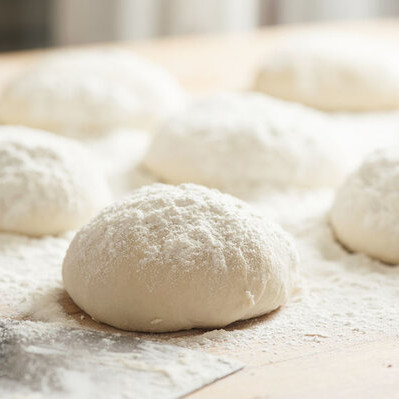Xylanase
Also known as hemicellulases, arabinoxylanase or fiber-degrading enzymes
What is Xylanase?
Xylanase is one type of hydrolytic enzymes which targets arabinoxylan fibers naturally present in cereal flours, both refined and whole grain. It has been heavily used in the breadmaking industry over the last few decades. Especially, in the production of white bread, whole wheat bread, multigrain bread, and many other baked goods.
Along with dough conditioners, xylanase helps high-speed bakers produce high quality bread while achieving the highest:
- Process tolerance
- Quality
Origin
Xylanase can be obtained from fungal and bacterial fermentations.
Along with first generation lipases and pure fungal alpha-amylase, xylanase became a valuable tool for bakers who were struggling to replace or significantly reduce levels of potassium bromate and other oxidizing agents.
Function
Xylanase is considered a multifaceted enzyme which does not perform just one single function in yeast-leavened dough systems. Instead, it plays different roles that positively affect the gluten-starch matrix integrity. Thanks to its action on fiber constituents, it also promotes beneficial gluten-fiber interactions, and creates more favorable conditions for further gluten hydration.1,2
Xylanase helps obtain the following characteristics:
- Increased pan flow
- Higher dough extensibility
- Increased dough machinability during makeup
- Superior gas retention for optimum oven spring and product volume
- Stronger and more continuous gluten network to minimize gas bubble coalescence
- Finer and more even gas cell structure in the crumb
| EC Number | Substrate | Reaction Catalyzed |
|---|---|---|
| 3.2.1.8 | Arabinoxylans (both water-extractable and water-unextractable) | Random endo-hydrolysis of β-(1,4)-D-xylosidic linkages in xylan backbone of AXs |
Commercial production
Despite the prevalence of hemicellulases in cereal grains, large scale production relies on fermentation and downstream processing using modern biotechnology.
The following block diagram summarizes the commercial production of xylanase:

Application
Arabinoxylans (AXs) → Xylanase substrate
Xylanases hydrolyze or reduce the molecular size of arabinoxylans (AXs). The breakdown of WU-AXs (detrimental polymeric form) into medium-to-high molecular weight WE-AXs (beneficial form), improves dough handling properties and leads to a greater uniformity in overall product quality characteristics.
WU-Axs are thought to be present in discrete cell wall fragments that can form physical barriers for optimum protein aggregation through S–S bonding and may interfere with the formation of a strong gluten matrix during mixing.1,3
Later, as dough expands during proofing and baking, WU-AXs have a disrupting effect on gas bubble stability, thus affecting dough expandability and oven spring. When xylanases are used for the partial and controlled depolymerization of WU-AXs, they provide dough strengthening and confer a stabilizing effect on gas bubble structure.
Mechanisms used by xylanase to improve overall product quality
1. Hydrocolloid effect
WE-AXs are a soluble form of pentosans which function as natural gums or hydrocolloids. By holding large amounts of water, they increase the bulk viscosity of the liquid phase of dough, enabling the dough to better cope with the mechanical stresses found in the process line.
2. Oxidative gelation of WE-AXs
In the presence of hydrogen peroxide produced by GOX, ferulic acid residues in WE-AX chains can link adjacent AXs by forming diferulic acid bridges. This is known as oxidative gelation and creates larger and more stable molecules known as AX gels which reinforce the gluten network.
3. Protein-and-WE-AX interaction
Xylanase promotes further interaction between WE-AXs and gluten proteins to reinforce the polymeric gluten network and enhance oven spring. The formation of covalent linkages with gluten proteins takes place via reaction between ferulic acid residues of AXs and tyrosine residues of protein chains.
4. Dough relaxation effect
As the xylan backbone is further hydrolyzed and reduced, water which was previously held by the larger polysaccharide, is freed, and redistributed within the dough. The release of water is responsible for the extra viscous behavior and mobility of the dough.
5. Foam stabilization effect
By thickening the thin liquid film surrounding gas bubbles and gluten–starch matrix, WE-AXs create a more stable foam as higher viscosities of the liquid phase prevent the bubbles from moving upwards and disappearing into the atmosphere. This is especially very useful in prolonging oven spring and preventing early gas bubble coalescence.
Regulation
Similar to other enzymes, food lipases are GRAS (Generally Recognized as Safe) and often considered a food processing aid in the US. The FDA regulates their origin (food-compatible) and establishes limits to their use (if applicable) based on GMP.5
References
- M. Eugenia Steffolani, Pablo D. Ribotta, Gabriela T. Pérez, Alberto E. León, Effect of glucose oxidase, transglutaminase, and pentosanase on wheat proteins: Relationship with dough properties and bread-making quality, Journal of Cereal Science, Volume 51, Issue 3, 2010, Pages 366-373.
- Putseys, J.A., and Schooneveld-Bergmans, M. “Enzymes Used in Baking.” Industrial Enzyme Applications, Wiley-VCH Verlag GmbH & Co. KGaA, 2019, pp. 97–123.
- Van Oort, M. “Enzymes in Bread Making.” Enzymes in Food Technology, 2nd edition, Blackwell Publishing Ltd, 2010, pp. 103–143.

